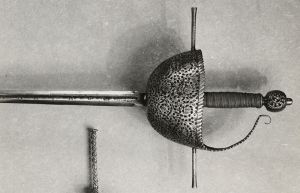
This is a slightly different topic for me. I’ve mostly been posting about kenjutsu, the Japanese sword art, but in fact that’s only one of several arts that I practice. Another is the Spanish rapier style La Verdadera Destreza (lit. “true art and skill” – in fact, the image at the top of the blog is my wife and I practicing this style.) A note about my background here: I was taught Destreza by a man who learned it while serving in the Army and stationed in Panama. He was taught by a Spanish expatriate living in Panama, who was taught the art in Spain. Assuming that all of this is true, I learned this as a living art, and (other than the few others who were taught by my teacher and the folks I’ve taught myself) I don’t know of anyone else who can say that.
Many people (notably the amazing Puck and Mary Curtis, with their Destreza Translation and Research Project) are attempting to reconstruct the art from the period writings. I’ve read their work, and as much of the period writings as have been translated to English (my Spanish is, shall we say, weak…or, more accurately, completely nonexistent). The principles of what they do are very much the same as what I was taught, but many of the specific techniques are different, and there’s a body of technique around my art that isn’t documented in any of the writings.
So, I thought I’d write a series of articles about Destreza as it was taught to me, for the benefit of anyone else who might be trying to learn. This first article in the series will be about the basic philosophy of Destreza, and how it differs from other similar systems; subsequent articles will look more closely at specific techniques and principles.
The central tenet of Destreza is don’t get hit. That probably seems unsurprising, but it’s actually quite different from other contemporary styles, such as the far-more-common Italian and French styles. To illustrate this, picture a simple attack-defense sequence in each style. In the Italian style, a typical version would be: attacker steps straight in and attacks; defender parries (possibly attempting to hit in a single tempo). The thing to note here is that if the defender misses his parry, he’s hit. He has no backstop.
An equivalent Spanish exchange would be: attacker (who we’re assuming to be Italian, since that’s what Destreza was primarily designed to work against) steps straight in and attacks; defender steps off line and interposes his sword, keeping his point in line but not necessarily attempting to hit in a single tempo. The body movement is the critical thing: as long as the defender gets off the line of the attack, it mostly doesn’t matter how badly he screws up his defense, he isn’t going to get hit regardless. Conversely, if he succeeds in interposing his sword, he’s safe even if he didn’t successfully get off the line in time. Of course, he’s sacrificed some time by stepping – his riposte isn’t going to be as fast as it would be if he stood still – but he’s a great deal safer.
The theory here is to build an impenetrable defense, and wait for the enemy to make a mistake. Of course, we (the Spaniards) are going to do everything possible to encourage that mistake. In particular, by moving offline, we force the enemy to turn to address us, which Italian and French fencers aren’t necessarily used to doing; if there’s a fractional hesitation before they can reestablish the line, we have our opening.
Even once the opening is found, however, our attacks are carefully chosen to maintain the exit line. Given a choice, we won’t attack straight down the enemy’s sword, because if he counterattacked simultaneously we’d both get hit. Double kills are not an acceptable outcome. We’ll nearly always move away from the sword, and preferably cover the line as well to prevent it from following us. Alternatively, we can control the sword as we move in, so that we can attack without risk of being hit.
If, at any point, we feel like we’re not completely in control of the situation, we’ll abort the attack and regain our chosen distance. If an opportunity is risky, says the practitioner of Destreza (diestro), it’s not really an opportunity. We have a strong defense, time is on our side, we can wait for the next one.
This philosophy shapes everything in Destreza. Next time, we’ll look at a few specific techniques, and relate them back to the central tenets. Also, in order to describe the techniques properly we’ll have to introduce the famous Spanish fencing circle, so there will be pretty pictures (or, well, pictures, anyway) next time, I promise.

8 replies on “La Verdadera Destreza”
[…] Thoughts along the martial Way « La Verdadera Destreza […]
[…] series of posts about La Verdadera Destreza, the Spanish rapier style, as I practice it. See parts 1 and 2 for some […]
[…] of posts about La Verdadera Destreza, the Spanish rapier style, as I practice it. See parts 1, 2, and 3 for the story so […]
Mate, this is fantastic and exactly what I wanted. Moving to part two with great antici…pation!
Reblogged this on legendaryrenegade.
I’m proud to announce that the book Destreza, historical fencing is available in English. For more information click on the following link
[…] Martial Traveler’s series of blogs on La Verdadera Destreza […]
[…] – https://martialtraveler.wordpress.com/2013/03/28/la-verdadera-destreza/ – https://www.martinez-destreza.com/articles […]